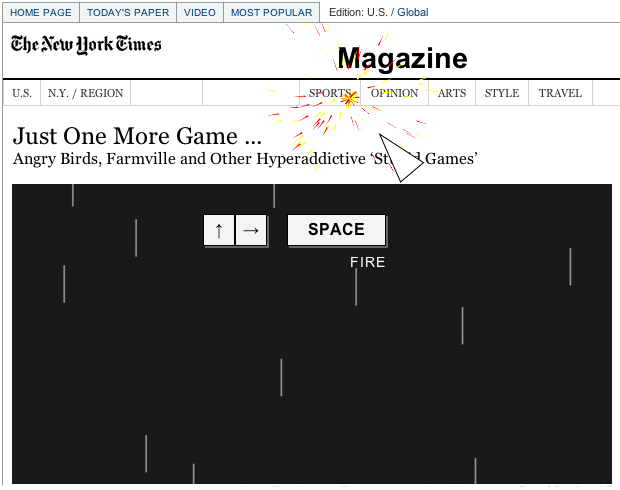New York Times' novel space game lets you 'blow up' website

It's not the first thing you expect to see when reading a lengthy, seven-page report on the nature of highly-addictive games, from old favourites like Tetris to modern hits like Angry Birds and FarmVille.
But the New York Times did exactly that to prove a point. I spent more time blowing up the website than I did on reading the article itself.

The game itself is the Kick Ass HTML-based game, which sits in your browser bookmark toolbar and can be activated as and when one wishes. A small triangle-shaped 'spacecraft' appears and with a few taps of the cursor keys and the space bar, you can start 'destroying' any website bit by bit. It is, in essence, a modern twist on the age-old arcade game, Asteroids.
But there is a more serious point to the article. The trouble is, as sister site CBS News noted quite poignantly: "While [the author] waxed poetic about the implications of "stupid games," we were busy shooting ads on the site."
There's a lesson to be learned here. The media is fickle. While in all honesty, the article itself was beautifully written and deeply interesting, in covering this story, I haven't seen a single retort about the story, rather the game itself was the story. It was the first time I actually enjoyed myself on the Times' website, but I'm a stickler for fun and shiny things, and I'll be the first to admit it.
The Times Magazine's Samantha Henig explained the reasoning behind the game's inclusion:
Among the early fans of the game was Jon Huang, a multimedia producer at The Times, who had the idea to modify Andersson’s open-source code to include with Anderson’s article. Because the game is open-source, he was able to modify the code to work on The Times’s site. “We realized we could tweak the nose or the ear a little bit and share a joke,” he said. “I wanted to share a joke with the reader.”
The game was in a perfect position to display ads. The Times' displays ads on its site, while many 'internal' ads point towards links to its digital subscription service past its paywall. From April 1, users will be asked to become digital subscribers once the 'free' 10 article limit is reached.
Considering how badly the advertising market has fared in during the late 2000's global financial crisis, no wonder advertisers are increasingly reaching to more interactive ads to engage their viewers and readers, and why online properties are ditching ads in favour of digital subscriptions and paywalled content.
But if there's one way to increase site duration visits, a game splashed above the 'lede' is bound to keep readers on the site for longer.
Image source: New York Times/ZDNet.
Related:
- CBS News: New York Times space game blows up ads
- Twitter bringing more promoted ads to mobile apps
- Microsoft goes 'Beyond the Like' with social ads solution
- Facebook explains ads to its users (video)
- Social engineering in action: how web ads can lead to malware
- Crowdsourcing ad relevancy: Do you care if ads are relevant to you?